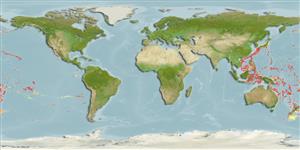Environment: milieu / climate zone / depth range / distribution range
Ecology
Marine; bathydemersal; depth range 253 - 580 m (Ref. 28982). Deep-water
Pacific Ocean: New Caledonia, southern Japan, and the Hawaiian Islands (Ref. 9824); including the Norfolk Ridge and Isle of Matthew (Ref. 28982).
Size / Weight / Age
Maturity: Lm ? range ? - ? cm
Max length : 22.5 cm SL male/unsexed; (Ref. 9824)
Dorsal spines (total): 0; Dorsal soft rays (total): 106 - 117; Anal spines: 0; Anal soft rays: 87 - 95; Vertebrae: 32 - 33. Body elliptical, its depth contained more than 2.4 times in SL. Tip of isthmus below posterior margin of lower eye. Eyes separated by a broad and concave space. Interorbital in male broader than that in female. Ctenoid scales on ocular side armed with a row of hairlike spines. Small dark blotches on origin of straight part of lateral line. Small dark dots along upper margin of upper eye.
Inhabits mud and sand bottoms (Ref. 9824). Benthic (Ref. 58302). Feeds on small benthic animals. Marketed fresh, sometimes dried-salted (Ref. 9824).
Life cycle and mating behavior
Maturities | Reproduction | Spawnings | Egg(s) | Fecundities | Larvae
Hensley, D.A. and K. Amaoka, 2001. Bothidae. Lefteye flounders. p. 3799-3841. In K.E. Carpenter and V. Niem (eds.) FAO species identification guide for fishery purposes. The living marine resources of the Western Central Pacific. Vol. 6. Bony fishes part 4 (Labridae to Latimeriidae), estuarine crocodiles. FAO, Rome. (Ref. 9824)
IUCN Red List Status (Ref. 130435)
Threat to humans
Harmless
Human uses
Fisheries: commercial
Tools
Special reports
Download XML
Internet sources
Estimates based on models
Preferred temperature (Ref.
123201): 6.8 - 13.9, mean 10.7 °C (based on 113 cells).
Phylogenetic diversity index (Ref.
82804): PD
50 = 0.5020 [Uniqueness, from 0.5 = low to 2.0 = high].
Bayesian length-weight: a=0.00912 (0.00408 - 0.02036), b=3.05 (2.87 - 3.23), in cm total length, based on LWR estimates for this (Sub)family-body shape (Ref.
93245).
Trophic level (Ref.
69278): 3.5 ±0.37 se; based on food items.
Resilience (Ref.
120179): Low, minimum population doubling time 4.5 - 14 years (Preliminary K or Fecundity.).
Fishing Vulnerability (Ref.
59153): Low vulnerability (17 of 100).
